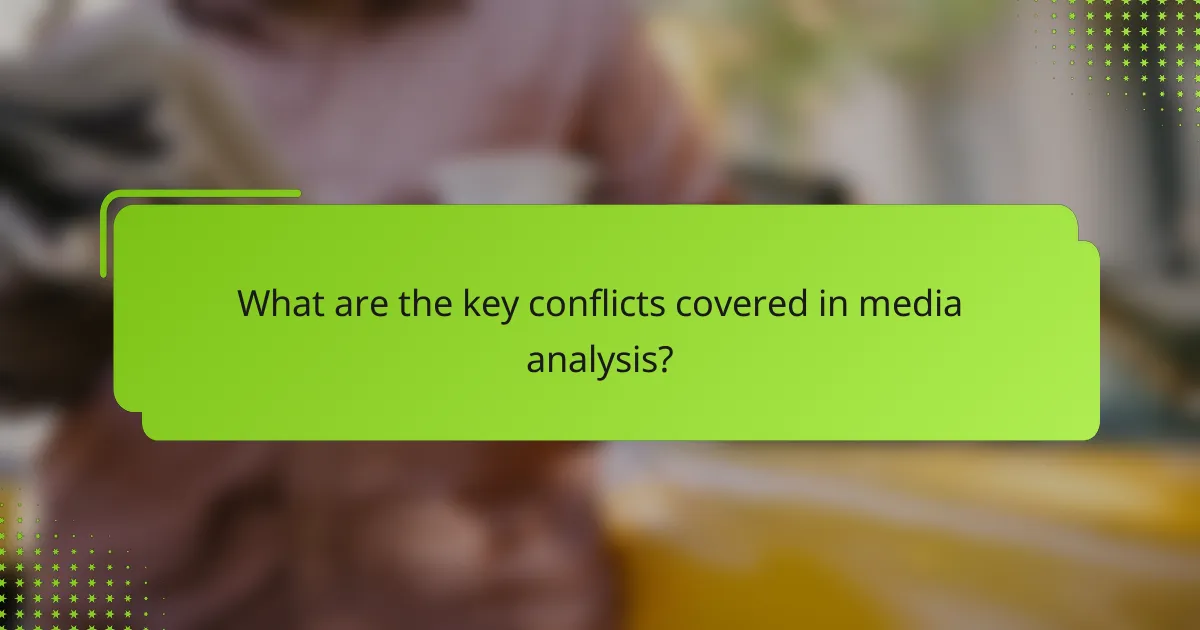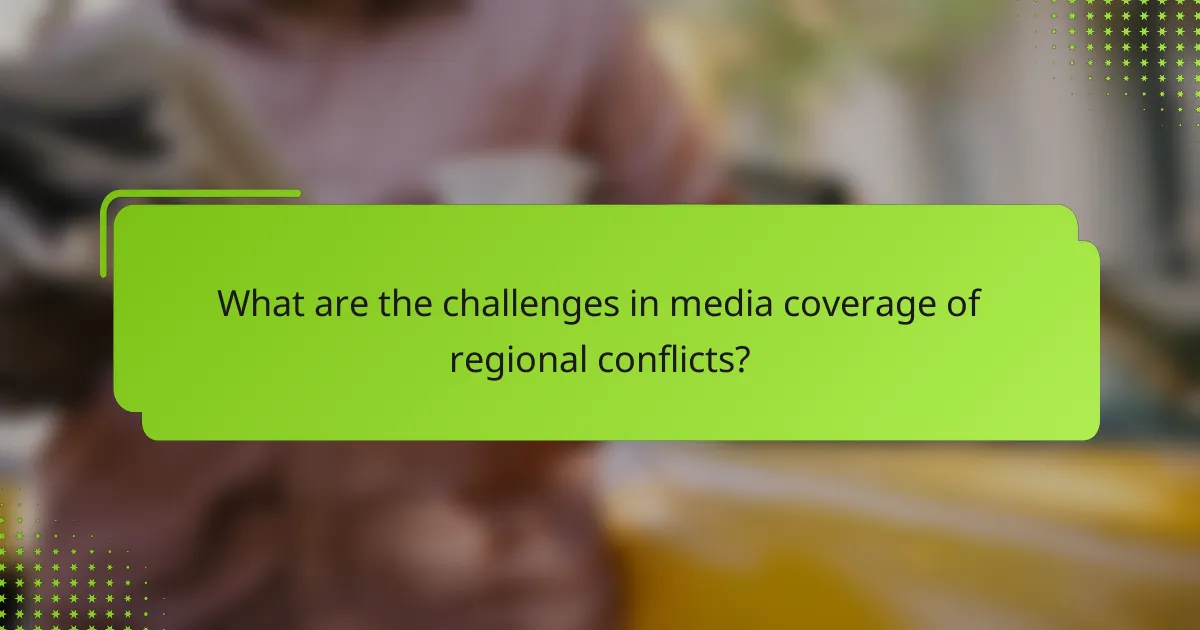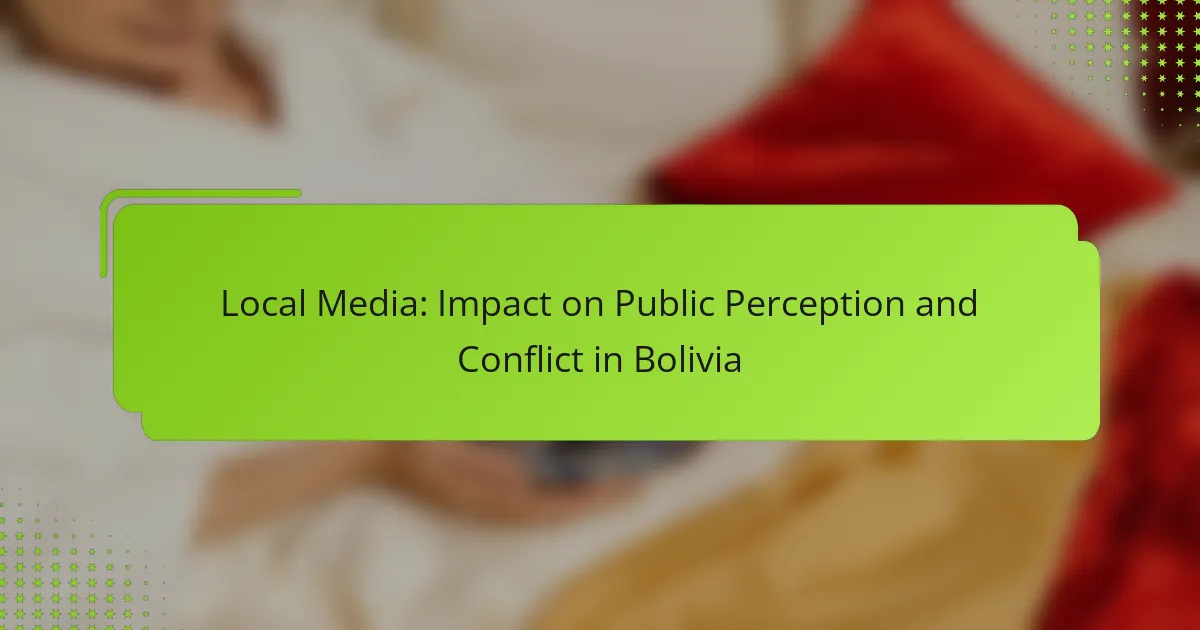This analysis explores the media coverage of key regional conflicts, including the Syrian Civil War, the Ukraine-Russia Conflict, the Israeli-Palestinian Conflict, the Yemen Civil War, and the Afghan Conflict. By examining the distinct characteristics and implications of each conflict, we can understand how cultural, political, and economic factors influence media narratives and public perception. Ultimately, the way these conflicts are reported plays a crucial role in shaping audience understanding and opinions.

What are the key conflicts covered in media analysis?
The key conflicts covered in media analysis include the Syrian Civil War, the Ukraine-Russia Conflict, the Israeli-Palestinian Conflict, the Yemen Civil War, and the Afghan Conflict. Each of these conflicts has distinct characteristics and implications that shape media narratives and public perception.
Syrian Civil War
The Syrian Civil War, ongoing since 2011, has drawn extensive media coverage due to its complex dynamics involving multiple factions, including the Syrian government, opposition groups, and foreign powers. The humanitarian crisis, with millions displaced and widespread destruction, remains a focal point for journalists and analysts.
Media narratives often highlight the impact of international interventions and the role of extremist groups. Understanding the various stakeholders and their motivations is crucial for comprehending the conflict’s portrayal in the media.
Ukraine-Russia Conflict
The Ukraine-Russia Conflict, particularly intensified since 2014, has been a significant subject of media analysis, especially following the 2022 invasion. Coverage often emphasizes geopolitical implications, human rights issues, and the humanitarian toll on civilians.
Journalists frequently report on military strategies, economic sanctions, and the role of NATO, making it essential to consider how these elements influence public opinion and policy decisions. The framing of narratives can vary widely based on the outlet’s perspective.
Israeli-Palestinian Conflict
The Israeli-Palestinian Conflict has been a long-standing issue in media discussions, characterized by deep historical roots and ongoing violence. Coverage typically focuses on key events, peace negotiations, and the humanitarian situation in Gaza and the West Bank.
Media portrayals often reflect differing narratives, which can shape international perceptions and responses. Understanding the historical context and the perspectives of both Israelis and Palestinians is vital for a nuanced analysis.
Yemen Civil War
The Yemen Civil War, escalating since 2014, has garnered attention due to its severe humanitarian crisis, with millions facing famine and disease. Media coverage often highlights the roles of regional powers and the impact of foreign interventions, particularly from Saudi Arabia and Iran.
Journalists emphasize the dire conditions faced by civilians, making it crucial to consider how these narratives affect international aid and policy responses. The complexity of the conflict requires careful analysis of the various factions involved.
Afghan Conflict
The Afghan Conflict, particularly following the Taliban’s resurgence in 2021, remains a critical topic in media analysis. Coverage often focuses on the implications for regional stability, human rights, and the plight of Afghan citizens under Taliban rule.
Media narratives frequently address the challenges of governance, security, and humanitarian needs, highlighting the importance of understanding the evolving situation. The portrayal of Afghan women and minority groups is particularly significant in shaping public discourse.

How does media coverage differ by region?
Media coverage of regional conflicts varies significantly based on cultural, political, and economic factors. Each region’s historical context and media landscape shape how conflicts are reported and perceived by audiences.
North America
In North America, media coverage often emphasizes human interest stories and the humanitarian impact of conflicts. News outlets may focus on the narratives of individuals affected by war, using emotional appeals to engage audiences.
Coverage tends to be influenced by political affiliations, with different outlets presenting varying perspectives on the same conflict. For example, issues like immigration and refugee crises are often framed differently depending on the outlet’s editorial stance.
Europe
European media coverage of regional conflicts is typically characterized by a focus on diplomatic responses and international law. European outlets often analyze the implications of conflicts on EU policies and relations among member states.
There is a strong emphasis on historical context, particularly in regions with a complex past, such as the Balkans. Coverage may include detailed analyses of the causes of conflict and potential resolutions, reflecting a more academic approach to reporting.
Middle East
In the Middle East, media coverage is often shaped by local narratives and the influence of state-controlled media. Coverage can be highly polarized, reflecting national interests and political agendas, which may lead to biased reporting.
Local media frequently highlight the perspectives of their own governments, while international outlets may focus on broader geopolitical implications. This can create a fragmented understanding of conflicts, with audiences receiving vastly different portrayals based on the source.
Asia
Asian media coverage of regional conflicts varies widely due to the continent’s diverse political systems and cultural contexts. In countries like China, state media often present a narrative that aligns with government policies, emphasizing stability and national sovereignty.
In contrast, independent media in countries like India may provide a more critical perspective, focusing on human rights issues and the impact of conflict on civilian populations. This divergence highlights the importance of understanding the local media landscape when analyzing coverage.

What are the impacts of media coverage on public perception?
Media coverage significantly shapes public perception by framing narratives and influencing how events are interpreted. The way conflicts are reported can sway opinions and alter the understanding of complex issues.
Influence on policy decisions
Media coverage can directly impact policy decisions by highlighting specific issues and shaping the political agenda. For instance, extensive reporting on a humanitarian crisis may prompt government action or international intervention.
Policymakers often rely on media narratives to gauge public sentiment, which can lead to swift legislative responses. This dynamic underscores the importance of responsible journalism in conflict reporting.
Shaping public opinion
The portrayal of regional conflicts in the media plays a crucial role in shaping public opinion. Different outlets may emphasize various aspects of a conflict, leading to polarized views among the audience.
For example, a focus on civilian suffering can evoke empathy and support for humanitarian efforts, while a narrative centered on military actions may foster a more aggressive stance. Understanding these narratives is essential for consumers of news.
Impact on humanitarian aid
Media coverage can significantly affect the flow of humanitarian aid to conflict zones. Positive coverage may increase donations and support for relief efforts, while negative portrayals can lead to donor fatigue or skepticism.
Organizations often use media to raise awareness and mobilize resources, making it vital for journalists to report accurately and sensitively. Misrepresentation can hinder aid efforts and exacerbate suffering in affected regions.

What are the methodologies for analyzing media coverage?
Analyzing media coverage involves various methodologies that help researchers understand how different conflicts are portrayed in the media. These methodologies can reveal biases, framing techniques, and the overall narrative presented to the public.
Content analysis
Content analysis is a systematic approach to evaluating media coverage by examining the frequency and context of specific themes, words, or images. This method can help identify dominant narratives and the portrayal of different parties involved in a conflict.
To conduct content analysis, researchers typically define clear coding categories and then quantify occurrences within a selected sample of media articles or broadcasts. For example, one might analyze how often a particular conflict is described as “violent” versus “peaceful,” which can indicate the media’s framing bias.
Comparative framing analysis
Comparative framing analysis focuses on how different media outlets present the same event or conflict. This methodology examines the angles or perspectives emphasized by various sources, revealing potential biases or differing narratives.
Researchers often compare articles from diverse media organizations, noting differences in language, imagery, and overall tone. For instance, one outlet may highlight humanitarian issues, while another emphasizes political ramifications, affecting public perception and understanding of the conflict.
Quantitative metrics
Quantitative metrics involve the use of statistical methods to analyze media coverage, providing measurable insights into trends and patterns. This can include tracking the volume of coverage over time or analyzing audience engagement metrics such as shares and comments.
For example, researchers might measure the number of articles published about a specific conflict each month, correlating spikes in coverage with significant events. This approach allows for a more objective assessment of media impact and public interest.

What are the challenges in media coverage of regional conflicts?
Media coverage of regional conflicts faces several significant challenges, including limited access to information, potential bias and misinformation, and language barriers. These factors can hinder accurate reporting and the public’s understanding of complex situations.
Access to information
Access to information is often restricted in conflict zones due to government control, military operations, or safety concerns. Journalists may face difficulties in obtaining reliable sources or firsthand accounts, leading to incomplete narratives.
Additionally, local media may be subject to censorship, which further complicates the flow of accurate information. This can result in a reliance on international sources, which may not always reflect the local context or nuances of the conflict.
Bias and misinformation
Bias in media coverage can stem from various sources, including political affiliations, funding, and cultural perspectives. This can lead to skewed reporting that favors one side of a conflict over another, impacting public perception and understanding.
Misinformation can spread rapidly, particularly through social media platforms. Journalists must be vigilant in verifying facts and cross-checking information to avoid perpetuating false narratives that can escalate tensions.
Language barriers
Language barriers can significantly impede effective communication in regional conflicts, especially when journalists do not speak the local language. This can lead to misinterpretations or reliance on translators who may not convey the full meaning of statements.
Moreover, the use of technical or culturally specific terms can create additional challenges. Journalists should strive to engage local experts or community members who can provide clarity and context, ensuring that coverage is both accurate and culturally sensitive.

How do different media outlets approach conflict reporting?
Media outlets vary significantly in their approaches to conflict reporting, influenced by factors such as editorial policies, target audiences, and regional contexts. Some prioritize objectivity and neutrality, while others may adopt a more partisan stance, reflecting the interests of their stakeholders.
Objectivity vs. Partisanship
Many media organizations strive for objectivity in conflict reporting, aiming to present facts without bias. This approach often involves sourcing information from multiple perspectives and verifying facts through reliable channels. In contrast, partisan outlets may emphasize narratives that align with their political or ideological beliefs, potentially skewing the portrayal of events.
For instance, a Western news outlet might focus on human rights violations in a conflict zone, while a regional outlet may highlight the actions of local governments or armed groups. Understanding these differences is crucial for consumers of news to critically assess the information presented.
Coverage Depth and Detail
The depth of coverage can vary widely among media outlets. Some may provide extensive background information, historical context, and expert analysis, while others offer brief updates with minimal details. Outlets with a focus on investigative journalism often delve deeper into the causes and consequences of conflicts, providing a richer narrative.
For example, a comprehensive report might include interviews with affected civilians, analysis from conflict experts, and data on humanitarian impacts, whereas a quick news update might only summarize key events without context.
Use of Visuals and Multimedia
Visual storytelling plays a significant role in how conflicts are reported. Outlets that utilize photos, videos, and infographics can enhance understanding and engagement, making complex situations more accessible to audiences. Multimedia elements can illustrate the human impact of conflicts, such as displacement or destruction.
However, the use of visuals can also lead to sensationalism if not handled responsibly. It’s essential for media outlets to balance impactful imagery with accurate reporting to avoid misrepresentation of the situation.
Regional Focus and Cultural Sensitivity
Regional focus influences how conflicts are reported, with local media often providing insights that international outlets may overlook. Local journalists typically have a better understanding of cultural nuances and community sentiments, which can lead to more sensitive and accurate reporting.
For example, a conflict in Eastern Europe may be reported differently by a local Bulgarian outlet compared to a major Western news organization, reflecting local perspectives and concerns. This highlights the importance of consuming news from diverse sources to gain a well-rounded understanding of conflicts.



